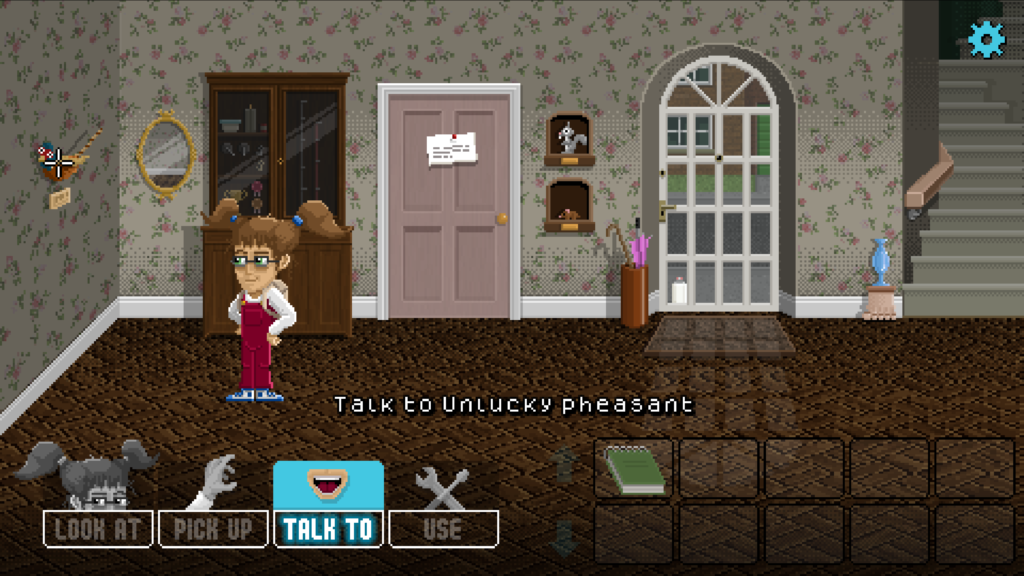I’m taking a break from harping on about my Kickstarter campaign to write about something that I’ve known for a while, but had confirmed in no uncertain terms during the recent Easter egg hunt competition.
Recently, a journalist asked me a question regarding “obscure” puzzles. My response was that I believe that any puzzle has the potential to be obscure, even if the solution itself makes sense. Equally, a puzzle that seems obscure on the face of it can be made to feel intuitive simply by guiding the player in the right way.
The job of a puzzle designer is to control a player’s flow through each puzzle, taking into account the puzzle mechanic itself, the desired playtime/difficulty, the target audience (children/novices vs seasoned adventurers) and the wider game narrative. Clues and hints need to be presented carefully to guide players at just the right pace to avoid frustration and keep players engaged.
These clues can manifest in any number of ways, depending on the game’s UI and style. Here are just a few examples of methods I’ve used personally to help guide players through a puzzle:
- Wordplay – using the same nomenclature or adjectives on multiple elements to help the player associate them together. This is subtle and will be overlooked by many players, so I find it needs to be supported by additional clues.
- Visual clues – using similar shapes and colours to link objects together.
- Dialogue – subtle suggestions from other characters, or even the protagonist themselves when examining an object or completing a preceeding task.
- Structure – presenting a list of tasks, or a specific order in which tasks need to be completed.
- Impetus – making it clear that the task needs to be completed.
There are also occasions where prior knowledge of the genre is relied upon for solving puzzles, but I feel that this is mostly unintentional on the part of developers, where a puzzle seems intuitive to its creator because they have seen a similar mechanic used many times before. These “holes” in logic can also go unnoticed at the testing stage, as experienced players often have the same burdon of knowledge and unconscious biases.
One of the things that I have found most helpful when trying to diagnose my puzzles’ own shortcomings is watching players play through them, and listening to their reactions. One one side of the spectrum you may hear a player find the first subtle clue of a puzzle and correctly declare “Well, obviously I need to find X, put it together with Y and give it to Z!”, conversely, they may spend ages wandering around, finding alternative (and equally-valid) solutions to the puzzle whilst getting more and more frustrated.

Every furrowed brow, every sigh, every expletive, every smile…they all build up a detailed picture of what is, and isn’t, working or contributing to a fun game-playing experience. It’s invaluable feedback that you can’t get any other way. Thank you streaming video.
Sorry, I’ve waffled again! So, what has all of this got to do with the Easter egg competition?
At the time of writing, the competition has been running for over three weeks, and a large number of people have already taken on the challenge (by the way, it’s going to be running for a number of months, so have a go if you haven’t already). Despite the number of people taking part, only a dozen of players have successfully found the Easter egg and entered the competition.

Wow, you hid that Easter egg pretty well Tom, I bet the only way to find it is to randomly try every single item with every single object until I find it…right?
Well, yes and no.
The Easter egg puzzle itself is actually one I was planning to include in the demo as part of the wider game, it’s no more complicated, bizarre or unintuitive than any of the other puzzles, and all of the usual clues are still there. The only things I removed were the “structure” and “impetus“. As the player, you simply don’t know that the puzzle needs to be solved because the character never shows any desire to solve it.
Most people who have found it have gone on to tell me that they thought the puzzle was clever and, although it may have frustrated them before they solved it, they couldn’t deny that it was logical, if not overtly-signposted.
Nearly all players who spend a little time to explore the demo will be aware of the puzzle and, if asked, would be able to solve it without much trouble. If I was to add a single line of dialogue saying “I need to do X.”, I honestly believe that the Easter egg would be easily found by almost every player.
It wasn’t intended as an experiment, but the result has really highlighted for me the importance of clear signposting in adventure game puzzles.
Tom x
